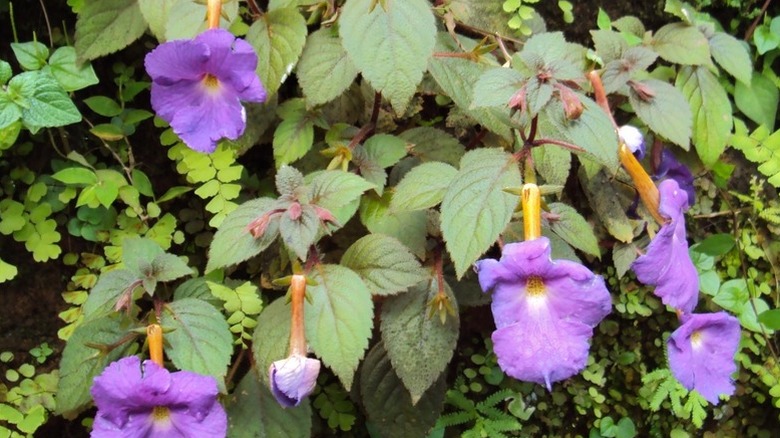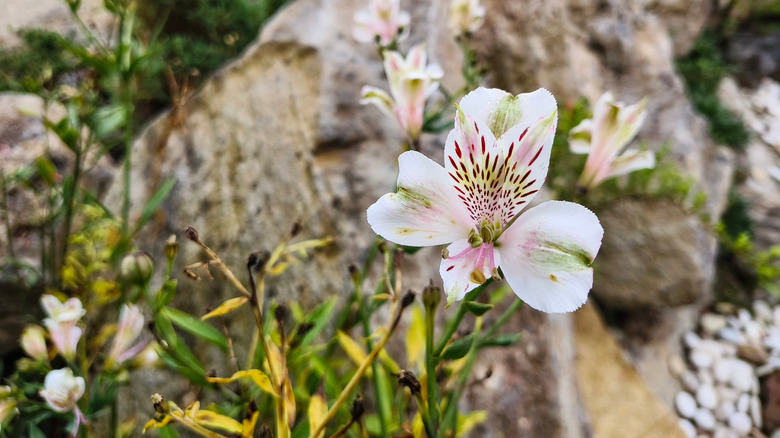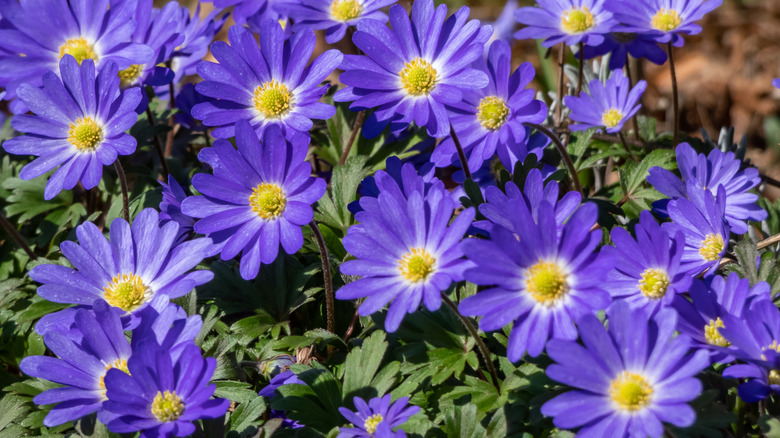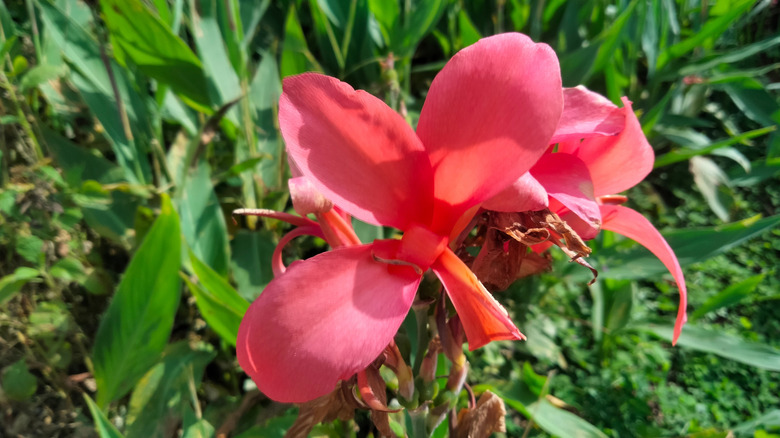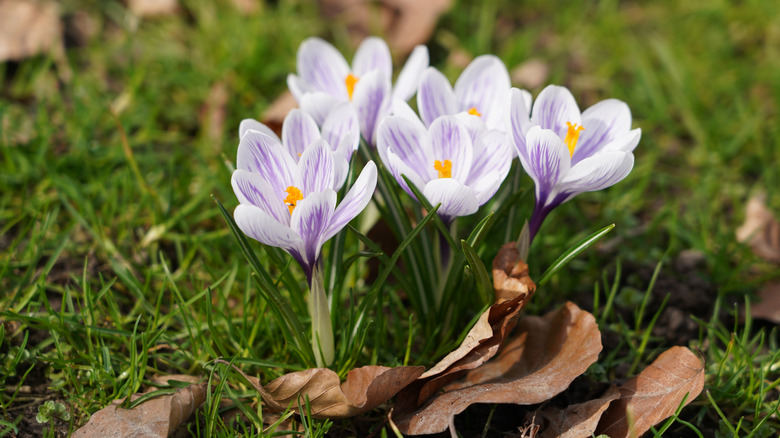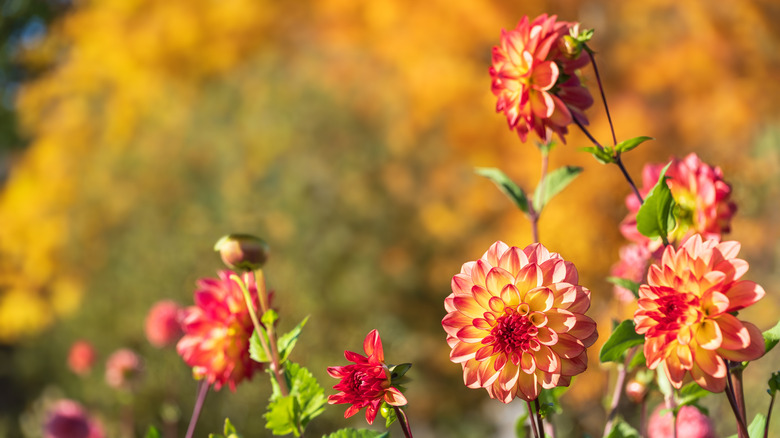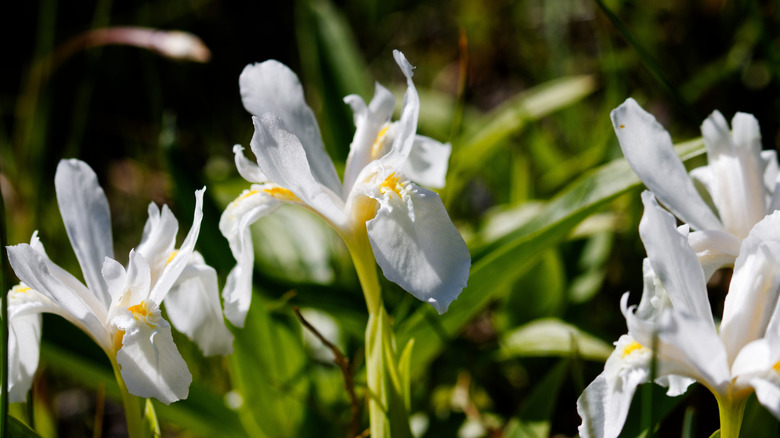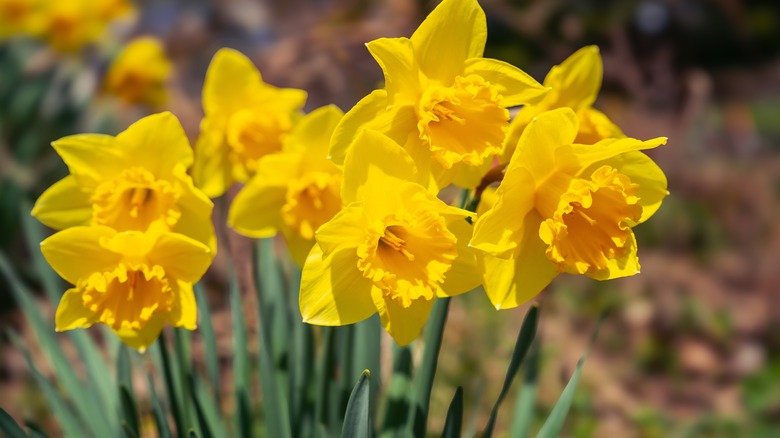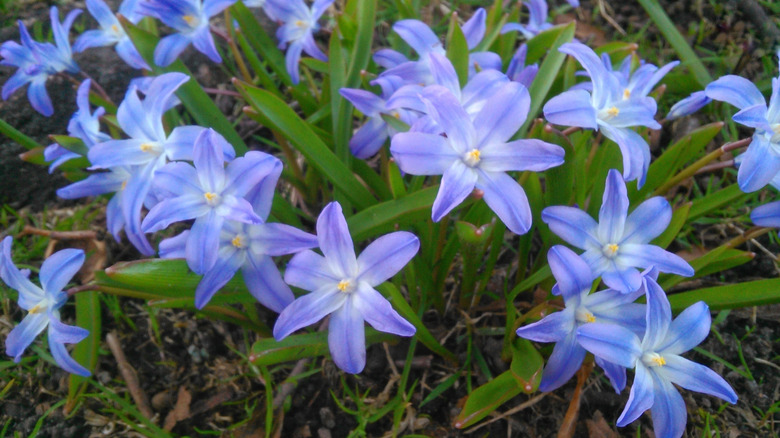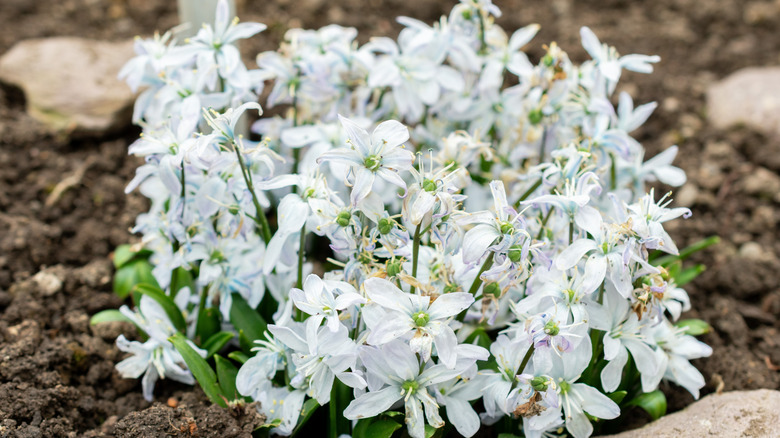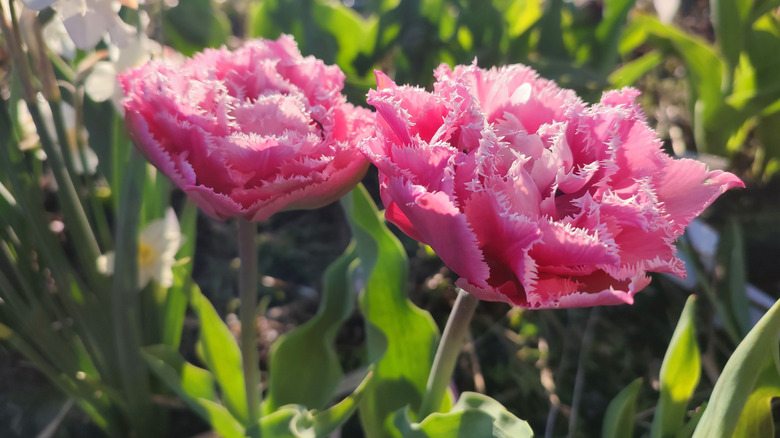17 Of The Fastest-Growing Flower Bulbs To Transform Your Garden Quickly
Even though gardening is often praised as a calming and peaceful activity, it can also be quite challenging. Whether sowing seeds or planting nursery starts, you usually have to wait a long time to see results, assuming you see any at all (natural elements and rodents can wreck the best plans). However, with some of the fastest-growing flower bulbs, like canna lilies, dahlias, Grecian windflowers, crocuses, squills, and many others (as you'll soon discover), you can watch your garden transform in a shorter amount of time.
The beauty of planting flower bulbs with impressive growth rates is that it allows you to experiment with the garden design. Picking up a color scheme, companion planting, and filling in seasonal gaps becomes immensely easier when you know you will see the results soon enough. So, grab your trowel and get ready to plant some of the prettiest, fast-growing flower bulbs that'll have your garden looking incredible before your patience gives out.
Hot water plant
Boasting petunia-like blooms atop fuzzy, ornate foliage, the hot water plant (Achimenes spp.) is an excellent bedding choice in tropical gardens located in zones 10 and 11. Don't lose heart if you stay outside that range, as plenty of pink and purple-hued hybrids are available that overwinter through zone 7 or can be brought inside as houseplants. The hot water plant needs a dry, shady spot and must be watered with warm water. After blooming throughout the summer and autumn, it'll go dormant in the winter. It can become floppy under the weight of its flowers.
Lily leek
Planted in fall, lily leek (Allium moly) will sprinkle your spring garden in waves of star-shaped, yellow blooms. Since it's a fast grower, many gardeners use it to fill out bare patches where its easy adaptability to diverse soil conditions is equally valuable. However, if you plan on growing it in formal beds, deadhead the spent blooms to prevent self-seeding and separate any unnecessary offsets. Lily leek is perennial in zones 3 through 9. While it prefers full sun exposure, shade protection is appreciated in hot summers. Plant in drifts for the highest impact.
Alstroemeria 'Casablanca'
One of the hardiest varieties of white Peruvian lilies, Alstroemeria 'Casablanca' can survive mercurial drops to -8 degrees Fahrenheit. This places its hardiness range to zone 6b through 9, with mulch for additional protection. Casablanca's pink-splashed, white flowers are supported by sturdy, green stems that look spectacular in vases for nearly two weeks, making it perfect for a cut flower garden. Alternatively, you can plant their bulbs in spring in sunny beds to attract hummingbirds, bees, and butterflies all summer long, sometimes even in the fall. Since direct contact can irritate the skin, wear gloves before handling it.
Grecian windflower
Grecian windflowers (Anemone blanda) are gorgeous flowers you can plant in fall to kickstart a stunning spring garden in zones 5 through 9. Their tiny, 6-inch-high clump is covered in sprays of purplish-blue flowers for about a month that pollinators find attractive, until it goes dormant in the summer. As Grecian windflowers prefer shady sites, they make excellent specimens for woodland settings or to naturalize the hostile ground underneath overgrown shade trees. But you must watch for cutworms. Because Grecian windflowers can cause contact dermatitis, you'll need gloves at the time of planting as well as during division.
Garden canna
Garden canna or canna lilies (Canna x generalis) are popular summer bulbs you can add to your garden in zones 8 to 11 to attract bees and hummingbirds. Given the wide range, you're likely to find plants as short as 2 feet to ones that tower 6 feet high. Their tropical leaves boast variegated patterns, while lipped flowers can be colored salmon, ivory, pink, or white. These plants are heat-tolerant and look their best when massed in sunny beds. Sadly, they do require lots of care, as Japanese beetles, aphids, slugs, and snails love to chew through their foliage.
Dutch crocus
One of the fastest-growing flower bulbs, Dutch crocus (Crocus spp.) deserves a spot in every landscape that needs an early wake-up from dormancy. Once planted in the fall in a partially shaded or sunny site, this low-maintenance, low-growing perennial explodes into whitish-purple flowers as early as February in zones 3 to 8. However, if squirrels overrun your garden or yard during the cold months, skip this plant, since they'll hoard away the bulbs, leaving you with no flowers. Plant them en masse, especially amidst ornamental grasses or perennials, where their early blooms can offer color until they green up.
Dahlia
Dahlias (Dahlia spp.) are fast-growing bulbous perennials that you may successfully overwinter in zones 7 through 10 with mulch. Beyond that range, you must dig out the tubers in the fall and plant them in the soil after frost danger has passed. Boasting a wide array of colors and forms, dahlias are bedding favorites for their long blooming season that lasts from summer through frost. Removing the spent blooms continuously encourages reblooms. Water your dahlias judiciously, especially in peak summer months, or they will decline in appearance. Use them in pollinator gardens to enjoy the presence of hummingbirds and butterflies.
Amaryllis
In zones 7 to 10, amaryllis (Hippeastrum spp.) bulbs are started indoors in early spring and transplanted outside for fiery red, white, or pink blooms toward the season's end or early summer. There, they're planted in moist, fertile soils with full sun exposure or moderate shade. In areas cooler than zone 7, amaryllis bulbs are potted indoors mid-fall through the winter. Due to their fast growth, they're in bloom within five weeks of planting. As a bonus, you can encourage them to produce a second flush by locating them in a brightly-lit location where they're regularly watered and fertilized.
Spanish bluebell
Spanish bluebells (Hyacinthoides hispanica) form a beautiful drift of lavender-blue when they're in bloom in late spring. In areas where temperatures don't dip below 14 degrees Fahrenheit, their bulbs can be planted in the fall; otherwise, wait until after spring frosts have passed to get them into the soil. Spanish bluebells grow vigorously and may spread in the landscape through self-seeding and offsets. So, site them in areas where they're free to roam or cordon with hardscape to contain them. Spanish bluebells are invasive in New Jersey. They tolerate dappled or partial shade but prefer full sun exposure.
Spring starflower
By getting spring starflower's (Ipheion uniflorum) bulbs into the ground by late fall, you can expect your early spring garden to greet you with a haze of bluish-violet flowers. You might even get to experience a layered fragrance with spicy onion notes when you move closer to enjoy these blooms. Spring starflowers can be aggressive, albeit non-invasive, and will spread through offsets and seeds. They're best utilized as shrub understories or in lawns when you wish to inject a pop of color until the existing plants grow out.
White crested dwarf iris
Rather than unfurling blue petals characteristic of the crested iris, its hybrid cultivar 'Alba' or white crested dwarf iris (Iris cristata 'Alba') delivers white blooms with yellow falls. Hummingbirds and bees are drawn to their spring blooms. This vigorous grower easily establishes and spreads in woodland settings of moist soils and partial shade through its rhizomes. Even when not flowering, 'Alba' looks ornamental because of its knife-edged foliage, which can function as a dense, deer-resistant groundcover. Be careful when you touch the plant as it can irritate the skin. 'Alba' overwinters in zones 3 to 9.
Tiger lilies
Named so because their red-blotched, orange flowers resemble a tiger's skin, tiger lilies (Lilium lancifolium) are another fast-growing option you may plant in spring for a summer bonanza. However, it's worth noting that tiger lilies can turn weedy thanks to the numerous bulbils they produce. If you aren't naturalizing the site, keep them in container gardens to minimize weeding. You must also resist planting them if you live in eastern states where they've a record of escaping into natural areas. Tiger lilies are cold-hardy in zones 3 through 9 and look their best when grown in multiples of three.
Daffodils
Available in various colors, including yellow, white, pink, and variegated versions, daffodils (Narcissus spp.) are some of the fastest-growing flower bulbs you can grow for an instant lift. They're planted in garden beds during autumn, and commence blooming in late winter or early spring, depending on the variety. Daffodils like full-to-part sun exposure and well-draining soils. To bring out that oomph factor, mass different varieties in groups of six or combine with other spring bulbs. Use them in borders frequented by deer and rabbits for deterrence in zones 4 to 8. Wear gloves before handling the bulbs and flowers to avoid skin irritation.
Star of Bethlehem
To naturalize sites receiving little sunlight or limited to merely morning or afternoon exposure, use the rapid-growing bulb, star of Bethlehem (Ornithogalum umbellatum). In late spring, this low-growing perennial, hardy in zones 4 to 9, will be decked in white blooms. These flowers tend to last into the summer, attracting bees. Sadly, it can become weedy and has even become invasive on the East Coast, where it shouldn't be planted. So, be on top of weeding or stick it into containers to limit its spread. Handling the plant without gloves can cause contact dermatitis.
Glory-of-the-snow
Aptly named, glory-of-the-snow (Scilla luciliae) brings glory to the dreary winter landscapes with its green stems topped in lilac blue blooms that poke out of the insulating flurries. These blooms last into early spring days until other flowers leaf out, and then the bulb goes dormant. Since the display can be short-lived, pair them with evergreens or use them in lawns where they'll provide much-needed color until the grass greens up. This low-maintenance perennial overwinters in zones 3 through 8 and prefers full-to-part sun exposure.
White squill
With their bulbs in the ground by fall, white squills (Scilla mischtschenkoana) are all set to produce pale blue flowers during the late winter months, making them another fast-growing bulb. These deer-resistant perennials are compact in size, growing no higher than 6 inches. As opposed to creating an intentional design, plant your bulbs haphazardly for a soft and natural look. They look really nice underneath deciduous trees, where their full sun needs are met for the flowering duration until they go dormant. Hardy in zones 4 through 8, they enjoy organically rich, sandy soils.
Tulips
Tulips (Tulipa spp.), planted in October (or even December if the soil remains workable), produce colorful blooms during spring. Save for species tulips that behave as perennials, standard tulips and their hybrids are grown as annuals. Offer these fast-growing bulbs excellent drainage so they do not rot. In sunny borders or beneath tall plantings, mass them in groups of 10 for the best effect. Since tulips become bare in the summer, consider double-cropping that area with daylilies or ornamental grasses.

